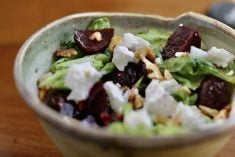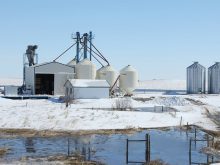VITTORIA, Ont. – Peanut farmer Ernie Racz, one of only two in Canada and the largest, coats his anger about inadequate Canadian farm policy with a humour as appealing as the maple syrup that glazes some of his peanut products.
He tells visitors that nearby Vittoria, a tiny village in the middle of Ontario tobacco country, is the peanut capital of Canada.
He said his garlic-flavoured peanuts are created by planting garlic beside peanut rows so the flavour can transfer between the plants in the ground.
Read Also

Communication key to bridging generation gap
Each generation is shaped by the predominant forces at play during their formative years. Acknowledging these influences can improve communication among the generations.
He called his Kernal Peanuts farm roadside store where he and wife Nancy sell most of their annual production, “the little nut shop in the middle of nowhere.”
But his farm, converted from tobacco to peanuts in 1986, is serious business.
His 100-150 acres of peanuts each year produce 360-900 kilograms of product per acre. This year, it will be close to the top production range on 100 acres or approximately 90,000 kg of peanuts.
Racz said it is a seven-day-a-week business that provides a decent living “but I would have made more money if I had stayed in tobacco.”
And the 58 year old has no plans to pass it on to his children.
“They have been bad, but not so bad that I would wish the farm on them.”
His bitterness comes from the fact that what was once a promising tobacco-replacement industry with 28 growers has been reduced to two farmers because the government allows 337 million kg of peanuts, mainly subsidized American product, into the country at prices less than Canadian production costs. Ottawa also denies Canadian farmers the minor-use chemicals they need and offers little support.
“The point is that if the government wants farmers, it has to support us,” he said. “If it doesn’t want us, then buy us out.”
But for all his complaints, Racz’s operation is a tale of tenacity, creativity and survival.
His harvester is a one-of-a-kind machine developed by a University of Guelph engineer for Canadian harvest conditions and the retail products he has developed are unique.
“You have to keep looking for new products,” he said. This year he is trying to grow a black peanut variety, and in his store he is selling white chocolate-coated popcorn grown by a corn producer neighbour.
The Racz operation is the remnant of a 30-year-old drive to find an alternative to the lucrative tobacco industry that sustained Norfolk County but was in decline because of growing health concerns about smoking.
Charlie Racz, Ernie’s father, bought the farm in 1947 and it produced tobacco for the next 39 years.
In the 1970s, it was discovered that the sandy soil and microclimate that sustained the Norfolk County tobacco industry made it the only area in Canada suitable for peanut production. Scientists at Guelph set about trying to create varieties that would grow in Canada’s shorter growing season.
An industry started and the first contracted peanuts were sold to United Protein in 1978. The company soon went out of business because of competition from American imports.
Still, 28 farmers entered the business and planted a peak acreage of 1,200 acres.
One day in the late 1970s, a researcher at Guelph gave Charlie Racz some seed peanuts left over from the research days.
He tried them on his farm, they grew and Ernie decided to “run with it” as a legume crop that liked the sandy soil and required no fertilizer because it fixes its own nitrogen. The Racz operation became a mixed peanut and tobacco farm.
There was a problem.
The American harvest technique is to cut the crop and leave it drying on the ground for two weeks before running the plants through a harvest machine that separates the shelled peanuts from the stalk. The short growing season does not leave Canadian producers that two-week drying period and in the early years, losses were 37 percent.
Racz took the problem to the university and the result was a combine harvester that cuts the plant and detaches the shelled peanut in the same operation. The shelled peanuts then are put into a former tobacco kiln for drying the same day, reducing losses to an “acceptable” 10 percent.
He had two one-of-a-kind harvesters made by a local company that later went bankrupt.
“Now we have to make our own parts when they break, which adds to the fun.”
By 1986, the federal government was offering a tobacco quota buyout and Racz took it, converting to a strictly peanut operation.
He decided there was no point trying to compete in the bulk market, because “subsidized American imports kill you.”
Instead, he and Nancy decided to develop peanut products and sell them out of a store built on the farm. Value adding and the specialty product line mean they price most of their production not at import-competitive prices but at cost-of-production plus 10 percent.
Now, one-third of the crop goes to a specialty boiled-peanut market that services Chinese and East Indian customers in Toronto and other urban areas.
Most of the rest is sold out of the store.
“The products are unique, people hear about this little place in the middle of nowhere and business builds.”
Racz said it is a combination of drive-in customers, corporate gift buying and a busy Christmas season.
“We’re getting by,” he said. “But I’ll be here till I die. No one would take this place and work as hard as we do for the return.
“But still, how many people can call themselves the biggest farmer of anything in Canada? And farming is an addiction that doesn’t have enough counsellors to help us heal.”














